If we were to retain only two health food supplements it would unquestionably be the chlorella and the spirulina. These two superfoods with exceptional benefits to our health are both comparable and complementary !
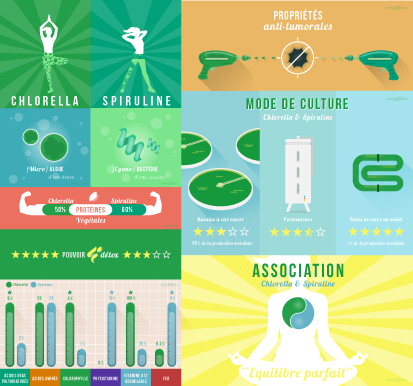
Organic Chlorella and organic spirulina are microorganisms that thrive in water. They are called “micro-algae ” because they are rich in photosynthetic pigments, they develop in water and they do not have roots. However, only chlorella is an alga, spirulina is a cyanobacteria. Cyanobacteria have traditionally been classified as algae, referenced as cyanophytes or blue-green algae, but today some treatises exclude them from algae. The commonly used name ” algae ” defines over 40,000 species.
Chlorella and spirulina are microscopic-sized foods that are at the very beginning of the aquatic food chain. They are ” microalgae ” from the large plankton family and more specifically phytoplankton.
Several thousand studies have been published on these two super health foods that are chlorella and spirulina. They have been among the most studied living organisms in the world for more than fifty years. All the in-vitro and in-vivo studies, and the first few clinical studies of the last few years, attest to their beneficial effects on health without ever showing any deleterious effects. By using high quality products, one can therefore, without running the slightest risk, test them and be impressed by their benefits, which are felt surprisingly quickly. Indeed, more than 80% of new consumers perceive the effects before the end of the first month.
Pour bien vous accompagner
Browse our guides
Benefits: two excellent health supplements
The properties of chlorella and spirulina
In summary, they help to:
- • Rid our body of pollutants (heavy metals)
- • Stimulate our immunity thanks to their immuno-modulating power
- • Contribute to the proper functioning of our cardiovascular system, protects our heart and liver
- • Contribute to the regulation of blood sugar levels
- • Fight against deficiencies in essential nutritional elements
- • Improve the quality of our mucous membranes and our skin (skin, nails, hair)
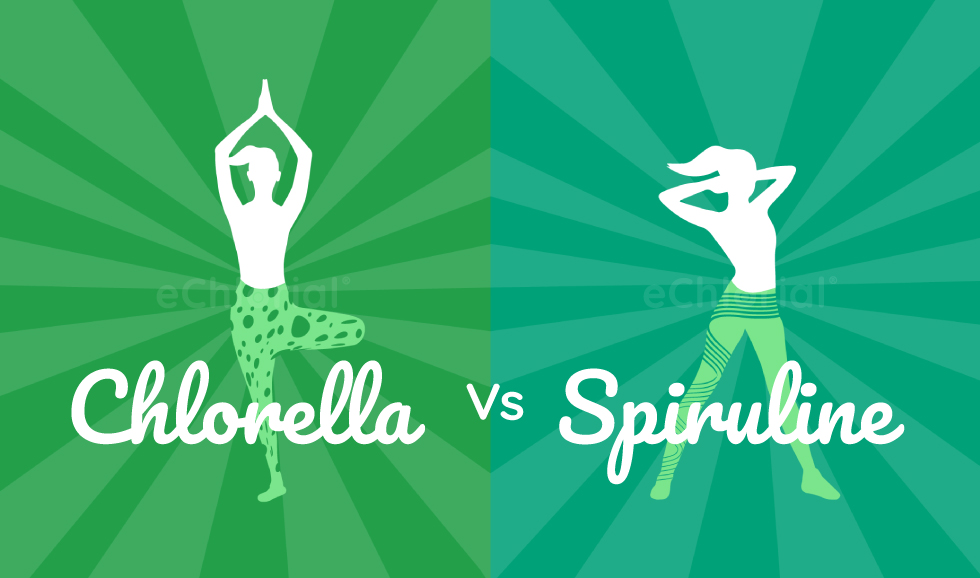
Many in vivo in vitro and human studies have tested chlorella (Martin 2018). (Panahi 2016, (Karkos 2011), (Mark 2017), to evaluate its potential benefits against cardiovascular disease risks, for chlorella (Na Hee Ryu 2014, Shimada 2009), or for spirulina (Mazokapakis 2014, Torres-Durran 2007).
Their abilities to regulate blood sugar levels can be a valuable aid, for spirulina (Ou Y 2013, 26 Ou Y 2012, Hamedifard 2019), as for chlorella (Ebrahimi-Mameghani 2017, Mizoguchi 2008, Merchant 2001, Panahi 2012).
Main differences between spirulina and chlorella – Complementarities
Different but complementary
Composition of Chlorella and Spirulina
While their average protein, carbohydrate and fat contents are fairly comparable, their caloric values and vitamin and mineral levels differ somewhat.
Chlorella is richer in omega 3 fatty acids, vitamin A, vitamin B2 (Riboflavin), iron and zinc. Spirulina contains more vitamin B1 (Thiamine), vitamin K1, more copper and depending on the strain, it can contain up to 10% more protein. Chlorella contains a vitamin B12 or cobalamin that is assimilable and active for humans.
More details:
Some “Average Values” in grams or % of the RDI (recommended daily dose), for 3 g per day of chlorella or spirulina, [4, 5]
| for 3 grams of : | Chlorella | Spirulina | |
| Calories | 14,8 | 10,4 | Calories |
| Proteins | 2 | 2 | Grams |
| Carbohydrate | 0,9 | 0,9 | Grams |
| Lipids | 0,4 | 0,3 | Grams |
| Vitamin A | 36,9 | 0,4 | % of RDI |
| Vitamin B2 (Riboflavine) | 9,1 | 7,7 | % of RDI |
| Vitamin B1 (Thiamine) | 4,1 | 5,7 | % of RDI |
| Folate | 0,9 | 0,9 | % of RDI |
| Magnesium | 2,83 | 1,8 | % of RDI |
| Iron | 26 | 5,7 | % of RDI |
| Phosphorus | 3,2 | 0,4 | % of RDI |
| Zinc | 17,1 | 0,5 | % of RDI |
| Copper | 0 | 10,9 | % of RDI |
| RDI : Recommended daily intake |
The components of Chlorella and Spirulina have been shown to be bio-assimilable and completely non-toxic to the heart, liver and kidneys (Neumann 2018).
Chlorella and spirulina are about 50% protein and are excellent natural sources of essential nutrients such as polyunsaturated fatty acids (omega 3 and omega 6) (Otles 2001, Tokusoglu 2006), vitamins, minerals and trace elements.
Chlorella provides more calories. It is richer in omega 3 polyunsaturated fatty acids, provitamin A, vitamin B2 (riboflavin), magnesium, iron and zinc. Unlike spirulina, chlorella contains a ” true ” vitamin B12.
Spirulina has fewer calories. It contains more vitamin B1 (Thiamine), vitamin K1 and copper. It contains a significant amount of vitamin B2 (riboflavin) and iron. About 80% of its vitamin B12 is a non-usable pseudo vitamin B12 (see below)
Studies have shown that some strains of spirulina can contain up to 10% more protein than chlorella (Lordan 2011, Bleakley 2017, Mark 2017, Neuman 2018 ). Spirulina proteins have been shown to be perfectly well absorbed by our bodies (Lordan 2011).
Interestingly, due to their high protein composition, NASA uses these supplements to enrich the diets of astronauts on missions (20 Karkos 2011).
• Omega 3 and 6
Chlorella and spirulina contain about the same proportion of lipids and are rich in polyunsaturated fatty acids (PUFAs or PUFAs in English), especially omegas (Panahi 2016, Otles 2001, Lordan 2011, Tokusoglu 2006).
Chlorella and spirulina provide PUFAs in kind and in different and complementary proportions. Indeed, chlorella contains more omega 3 than spirulina, which contains mainly omega 6. (Otles 2001, Kent 2015).
➤ Notes
Omega 3 and omega 6 are polyunsaturated fatty acids known as ” essential ” because our bodies do not produce them. They must absolutely be introduced into our diet in sufficient quantity and proportion. They are essential for the development of our cells and brain functions (Di Pasquale 2009).
A good balance of fatty acids in our diet, which favors polyunsaturated fatty acids and limits saturated fatty acids, tends to reduce the risk of cardiovascular disease (Hooper 2012, Hooper 2015, Mozaffarian 2010, Jakobsen 2009).
Omega 3s have been shown to have many beneficial effects on our health. In particular, they are able to reduce inflammation, improve bone quality, reduce heart problems and even some cancers. (Cazzola 2007, Terry 2004, Ciubotaru 2003).
If our diet is rich in sources of omega 6, it is poor in sources of omega 3 according to the SU.VI.MAX study (6) and the AFSSA-ANSES report [7]. Thus most populations, including the French population, are deficient in omega 3. It is recommended to consume at least one fifth of omega 3 of the omega 6 consumption.
In its notice of March 1, 2010, ANSES (8) reevaluated the recommended nutritional intake of lipids (which include omega 3 and omega 6): they should reach 35 to 40% of the total energy intake. It is recommended for adults to consume at most five times more omega 6 (LA) than omega 3 (DHA), that is, a ratio ” omega 6 / omega 3 ” of 5. In reality the average ratio is often more than 10, or even rather 15, which is far too !
Plant-based omega 3s, from algae, are considered more appropriate than animal-based ones. (Lenihan-Geels 2013).It should not be forgotten that if small fish are rich in polyunsaturated fatty acids (omegas) it is because they have consumed plankton, that is, microalgae that produce them. However, in spite of their omega 3 content, the only consumption of microalgae with the recommended average dosage does not allow to reach the recommended daily dose. Today we find extracts of microalgae that allow a good dietary supplementation in omega 3 of plant origin.
• Bio-available Iron
Chlorella and spirulina are rich in iron whose absorption by our body is at least 5 times more efficient than that from meat. Depending on the strain, 3 g of echlorial chlorella or 12 g of spirulina can provide up to 50% of the recommended daily allowance for adults
Iron from chlorella has been shown to be well assimilated by the body (Matsuura 1991)
➤ Recommendation
If iron intake is needed, chlorella is preferred.
For information:
The ANSES Recommended Dietary Allowances, 2016 Edition (9) or by the U.S. Institute of Medicine (Dietary Reference intakes 2001) (10), are variable according to age, gender, and physical activity. For people over 50 years old the recommended iron intake is 9 mg per day while for adult women and adolescents it is 16 mg. For pregnant women the recommended intake is 30 mg per day
• Other minerals and trace elements
Chlorella is therefore richer in iron than spirulina but also in phosphorus and manganese. Spirulina, on the other hand, is much richer in potassium and sodium (15 times more salt) as well as zinc than chlorella.
Chlorella and spirulina are rich in minerals and trace elements. They both contain, in the same proportions, magnesium, calcium and copper. They are complementary in their contributions of iron, phosphorus, manganese, potassium, sodium and zinc. These elements, in significant proportions, promote the acid-base balance of our body.
In case of diet it will be advisable not to neglect the salt intake of spirulina.
• Vitamin K1
Chlorella and spirulina contain vitamin K1 essential for clotting. Spirulina contains the most. Indeed 3 g of spirulina can provide up to 40 micrograms of vitamin K1, a value that approaches the dose recommended by health authorities. This is about 50 micrograms per day per adult, according to ANSES, which also recommends not exceeding a supplemental intake of 25 micrograms per day (ANSES 2007 report) (11) and 2011 (12). 3 g of chlorella can provide 1.8 micrograms of vitamin K1, a significant dose but nevertheless far from the recommended daily dose of 50 micrograms.
➤ Recommendation
If you are taking a high dose anticoagulant, chlorella should be preferred and spirulina should be avoided. In case of doubt, it is advisable to consult your doctor.
• Vitamin B12
In contrast to spirulina, chlorella (grown in glass tubes) contains B12 bio-assimilable and active vitamin B. Spirulina contains vitamin B12 but it is essentially a pseudo-vitamin B12 also known as the analogous B12 which is not active for humans (Watanabe 1999, Watanabe 2007). Only 10% to 20% of the vitamin B12 in spirulina is bioavailable, compared to 100% for chlorella.
Single supplementation of vegetarians with spirulina has been shown not to prevent vitamin B12 deficiencies (Rauma 2009).
➤ Recommendation
People who eat little or no meat, including the elderly, vegetarians, vegans, and people on meatless diets need to supplement with an absorbable vitamin B12. Chlorella is ideal for this good vitamin B12 supplementation.
• Pigments / Antioxidants
Antioxidants in our diet have been widely proven to have health benefits Douglas 2017).
Chlorella and spriulina are rich in polyunsaturated fatty acids (PUFAs) which are powerful antioxidants but they also contain other antioxidants such as vitamin C, vitamin E, and pigments : carotenoids and chlorophylls Lordan 2011.
Spirulina is rich in phycocyaninits specific pigment which is a very active antioxidant compound. It contains chlorophyll but in lesser proportion than chlorella.
Chlorella does not contain phycocyanin even though it is very rich in antioxidant It contains mostly chlorophyll, a particularly active antioxidant compound (Lee 2010). It has the highest chlorophyll content of any plant!”
For its exceptional chlorophyll content, chlorella is highly valued, especially for cleansing the body, detoxifying it and stimulating liver activity.
Clinical studies have confirmed the benefits of chlorella’s antioxidants, including one on Korean smokers that, in addition, showed its positive impact on DNA protection Lee 2010).
➤ Recommendation
In case of liver weakness it may be useful to start with a liver cleanse with natural products such as; Milk Thistle, Artichoke … before taking Chlorella. In case of doubt, spirulina can be chosen. It is recommended to take advice from a naturopath.
• Digestibility
Spirulina does not have a cellulose membrane, so it is quickly assimilated. It is more easily digested than chlorella and does not cause stimulation of intestinal functions.
Studies show that chlorella has a digestibility rate of over 70% depending on the strain and that its proteins just like spirulina’s are well assimilated (Kose Ayse 2017). There are no studies that would confirm the value of bursting the cells to make them more digestible (whether chlorella cells are burst or intact). The fibers that make up the cellulose membrane of chlorella (16 to 20%) are not assimilated. They allow the elimination of heavy metals and other pollutants they have trapped, helping to give chlorella its remarkable detoxification capacity.
➤ Recommendation
Spirulina is particularly well suited for anemic or malnourished people but also for athletes and anyone looking for a rapidly assimilable natural energy supplement.
Chlorella will thus be preferred by all those who want to stimulate their intestinal transit or rebalance it. Spirulina, whose assimilation is faster, will be preferred by athletes.
➤ Recommendation
In prophylaxis (prevention) or treatment, the use of both supplements, chlorella and spirulina, is particularly interesting.
(See Chlorella and Cancer chapter)
• Detoxifying action
Chlorella is to be preferred as a natural detoxification solution, effective and safe for the elimination of heavy metals and dioxins. The membrane of the chlorella which is not digested, will carry with it via the stools, the heavy metals that it will have chelated (hung).
Spirulina could be associated with chlorella for a detox objective. Indeed, phycocyanine has shown that it possesses very interesting detoxifying properties.
➤ Recommendation
Although spirulina has shown detoxifying abilities, chlorella is to be preferred in a body detox option.
It is imperative to choose a pure chlorella or spirulina, free of heavy metals and impurities. Their production under glass tubes is an assurance of quality production.
Spirulina and chlorella: two super health foods
Organic spirulina and organic chlorella: super health foods
Chlorella and spirulina are authorized by official bodies as food supplements (*). Spirulina was used long before the enactment of the ” novel food ” law of 1987. Therefore, it was not subject to a specific authorization request. In Europe, the arrival of chlorella is more recent, which explains why it is still little known. It joined the positive list of novel foods of the AFSSA-ANSES [2] in 2004. Like spirulina, it can be offered as a food supplement, a terminology framed by law.
(*) Food supplements are regulated by the European Parliament directive, transposed into French law by the decree n°2006-352 [1]. They are defined, according to Article 2, as ” foodstuffs the purpose of which is to supplement the normal diet and which constitute a concentrated source of nutrients or other substances having a nutritional or physiological effect alone or in combination…”.
The U.S. authorities (the FDA Food and Drug Administration) have given them the status of ” product recognized as safe for consumption ” : GRAS status Generally Recognized as Safe for spirulina (GRN No. 391) and chlorella vulgaris (GRN No.396 ) (3)
Natural detoxifiers, dopants, energizers
Chlorella and spirulina are among the “Top 10” most protein-rich foods, exceeding 50% of their dry weight! They also contain a multitude of essential nutrients that have many beneficial effects on our health. They are excellent natural dopants to be used in health prevention or in case of temporary or chronic weaknesses.
They are very valuable for people who are anorexic or weakened by age or illness. They are energy supplements very often used in supplementation of slimming, vegetarian or sports diets.
Organic chlorella and organic spirulina are the go-to allies for naturopaths. Most prescribe them as a first-line treatment, others after an initial liver cleanse when the liver is deemed too engorged. Milk thistle can be a useful agent in anticipation of a ” detox program ” with Chlorella and Spirulina. These health professionals are well aware of the detoxifying and stimulating properties of chlorella and spirulina.
The common actions of spirulina and chlorella
Summary of common actions
1) They cleanse/detoxify the body, which will then function better and longer
2) They act as immune modulators and stimulate immune defenses, so they keep us healthy by protecting us
3) Their cocktails of essential nutrients make up for our deficiencies and allow our bodies to function optimally thanks in particular to their incredible antioxidant content.
Chlorella and spirulina cleanse our bodies, enriching them with valuable nutrients including an array of antioxidants and boosting our immune system.
The virtues of chlorella and spirulina are linked to the cocktail of precious elements that compose them but also to the synergy that exists between them. They stimulate our natural defenses and clean our body from the many pollutants it accumulates over time.
They prevent our dietary deficiencies and slow the effects of aging on our cells thanks in part to their high antioxidant content and valuable nutrients.
Our experience of nearly 20 years as a distributor of microalgae grown in glass tubes, has taught us that consumers of chlorella and spirulina are those who are fully aware that they are the only ones who can act on their health and well-being. These health supplements are fully part of their lifestyle that they try to build as balanced and harmonious as possible. Indeed, the consumption of Health supplements is part of a controlled lifestyle approach with first of all, a healthy and diversified diet, regular physical and mental activities.
Spirulina and chlorella: specificities, differences and complementarities
Chlorella and its benefits
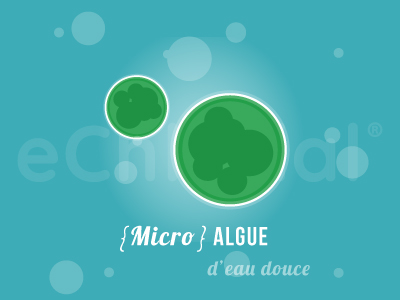
• Chlorella is a freshwater algae, a unicellular plant organism with a spherical shape. Appeared on earth about 2.5 billion years ago, chlorella is composed of a eukaryotic cell (which has a nucleus) whose size of 5 to 10 µm is close to that of a red blood cell.
• The composition of chlorella is an impressive cocktail of nutritional elements. It has a high percentage of proteins (about 50%), all the amino acids including the 8 essential ones. It contains a significant proportion of antioxidants, in particular the highest rate of chlorophyll of all plants (3 to 5%). It contains a multitude of vitamins, enzymes, peptides, minerals and trace elements, polyunsaturated fatty acids that represent a real cocktail with beneficial health effects. This cocktail constitutes what is commonly called the growth factor or CGF for “Chlorella Growth Factor”.
• The growth factor of chlorella gives the micro-alga its exceptional development and regeneration properties. It explains the revitalizing and repairing capacities of chlorella on the tissues whose production or reconstruction it stimulates.
• Among the many beneficial properties of chlorophyll, it has an exceptional cleansing or detoxifying power, now widely proven. It is also a powerful antioxidant that slows down the oxidation of cells. The properties of chlorophyll, particularly that of chlorella, are also well documented in scientific and medical literature.
• Chlorella is known for its energizing and stimulating properties of our immune system
• Chlorella has shown through its immune-modulating properties that it can help regulate lipid (lipid-lowering) and blood sugar levels (protection against type 2 diabetes).
• Chlorella vulgaris is a microalga well known for its cleaning or detoxifying properties. It eliminates heavy metals (lead, mercury, arsenic, cadmium…), dioxins, PCBs thanks to its high chlorophyll content and its chelating membrane, capable of fixing them. This membrane has a hyper affinity with heavy metals and various chemical compounds such as PCBs. The membrane of Chlorella is not assimilated, thus, once loaded with the toxic compounds which it hung during its passage in all our digestive system, it is directed towards the exit or it is eliminated via the stools.
• Chlorella contains a high level of antioxidants and prebiotics. It stimulates digestive and intestinal activity while balancing the flora.
• It promotes the rebalancing of the flora. Through its action on our gut, it affects our entire well-being. We now have proof that our health depends on the good balance of our intestinal flora or microbiota. Indeed, the latter is largely involved in our immune system but it is the seat of the production of neurotransmitters such as serotonin (the happiness hormone) and melatonin (the sleep hormone).
• Chlorella grown in glass tubes is particularly rich in bio-available vitamin B12. Our body does not produce vitamin B12, so it must be introduced through our diet. It is mainly found in meat.
A daily consumption of 3 to 5g of Chlorella provides the recommended requirement of vitamin B12. Consumption of Chlorella or Nori (Rauma 1995) has been shown to supplement vegetarians with vitamin B12.
Spirulina and its virtues
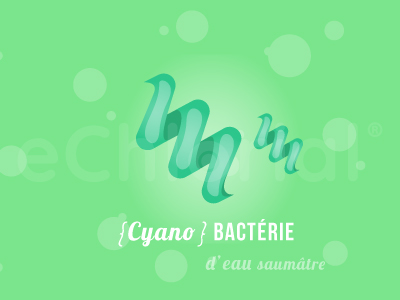
• Spirulina is a microphyte, a component of phytoplankton that belongs to the Cyanobacteria group. This cyanobacteria, commonly called ” blue-green algae “, is an organism twice as old as chlorella on the scale of our planet! Spirulina, a unicellular organism, has a prokaryotic structure (without a nucleus) typical of bacteria. Photosynthesis occurs directly in the cytoplasm of the cell. It is the main species of cyanobacteria cultivated industrially for its recognized properties on our health.
• Spirulina is composed of a super cocktail of nutritional elements valuable for health. It has a high percentage of protein (about 60%), the entirety of amino acids including the 8 essential. It contains vitamins, enzymes, peptides, minerals, polyunsaturated fatty acids.
• Spirulina is composed of a super cocktail of nutritional elements valuable for health. It has a high percentage of protein (about 60%), the entirety of amino acids including the 8 essential. It contains vitamins, enzymes, peptides, minerals, polyunsaturated fatty acids.
• Spirulina has shown its energizing and stimulating properties for our immune system.
• Spirulina has immune-modulating properties that are able to moderate blood fat levels (dyslipidemia).
• Spirulina contains phycocyanin(about 20%)and phycocyanobilin(about 1%), super antioxidant pigments, equivalent to“EPO.” It owes its blue color, but also most of its properties and in particular its ability to regenerate our blood cells, to these very special super active pigments.
Phycocyanin and phycocyanobilin have been shown to have exceptional properties on our health. The results of studies on the benefits of these pigments very specific to Spirulina are particularly numerous and well documented in the scientific and medical literature.
Who can benefit from chlorella and spirulina?
Chlorella and spirulina are detoxifying, energizing and stimulating foods that are :
– Suggested for people who suffer from problems related to pollutants such as heavy metals, for a gentle and safe detox
– Recommended for children, teenagers, seniors and pregnant or breastfeeding women,
– Suggested as a dietary supplement during slimming or vegetarian diets,
– Advised in cases of chronic hunger, blood sugar, diabetes (type 2)
– Very popular with anyone with skin, nail, hair problems
– Appreciated by those who experience depressive passages, sleep problems
– Very appreciated by the great athletes who seek to increase their performance with natural products. The now famous athlete Kilian Jornet, ultra-trail specialist, takes spirulina for example when he lacks iron.
These foods are for anyone who has decided to age well and take charge of their health.
Contra-indications of chlorella or spirulina?
Given the high bio-available iron content of chlorella and spirulina, people who suffer from hemochromatosis (excess iron) should not consume them.
Before consuming spirulina which contains a high content of vitamin K1, people who are taking high doses of anticoagulants, should first take the advice of their doctor.
In its 2014 report, the ANSES (13) considers that spirulina is not indicated for people with phenylketonuria (a rare genetic disease linked to the accumulation of the amino acid phenylalanine in the body) because it contains phenylalanine. It is the same for people with an allergic background.
How to consume them, alone or combined? As a cure or permanently?
The first intakes of chlorella and spirulina
It is possible that the first few intakes of chlorella may cause some nausea and diarrhea. These effects may be due to a liver reaction that is too strong on a liver that needs to be cleansed first. These discomforts can be caused by the chlorophyll. Heavy metal detoxification specialists consider that the initial painful reactions may be indicative of a high level of intoxication but that in the absence of perception the cleansing is quite effective.
Dosages used in scientific and medical studies
The dosage of spirulina that has been used in scientific and medical studies ranges from 1 to 10 g per day per adult. Published studies with chlorella use between 1 and 20 g of chlorella per day per adult.
The dosages recommended by health professionals vary from 3 to 5g per day when used for health prevention and up to 20g in the detoxification phase.
Choice and dosage depend on one’s own needs or goals
For optimized effects, chlorella and/or spirulina should be consumed daily. Regularity of intake is important. Even if the effects, notably on tone and well-being, are felt before the end of the first month, optimal effectiveness requires consumption over time, about 3 months, the average duration of a cure.
For a simple health prevention objective, one can choose to consume chlorella and spirulina alternately. The recommended dosage is 3 to 5 g per day per day for an adult. A cure per product is at least 3 months.
For a search for amplification of the doping effect, the association chlorella and spirulina is recommended. The dosage of chlorella and spirulina taken in combination can vary from 2 to 5 g per day and per product for an adult.
According to one’s own needs one will choose to consume chlorella and spirulina, alone or associated, in cures (of 3 months, 2 cures per year) or throughout the year.
Which products to choose: organic chlorella, organic spirulina, origin, production method?
Check the origin of the micro-algae
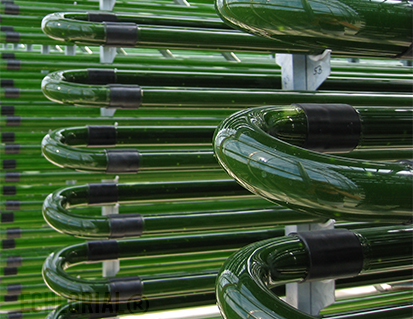
The majority of microalgae sold in Europe come from Asia. They are cultivated in the open air under very profitable economic conditions. They are sold at prices that can be very low, but most are to be avoided. It is very important to check thesource and the growing method of microalgae. Those that are grown in a closed and controlled environment, especially under glass tubes, are the microalgae with the best guarantees of purity and quality. There are now organic chlorella and organic spirulina grown in Europe.
Microalgae grown in “fermenters” can be found today in France. They are pure but, perhaps too ! Indeed they are cultivated in total absence of light in an almost sterile environment. These conditions of production are artificial because a plant develops naturally thanks to photosynthesis. These conditions explain the absence of vitamin B12 in these micro-algae. It should be noted that all scientific and medical studies that confirm the benefits of Chlorella and Spirulina have been conducted with microalgae that have developed naturally through photosynthesis.
Recommendation
It is recommended to choose microalgae or algae grown in Europe that grow by photosynthesis and not by fermentation. Cultivation under glass tube is to be preferred for its natural growing conditions and its quality guarantees.
Organic Chlorella and Spiruline, grown in Europe !
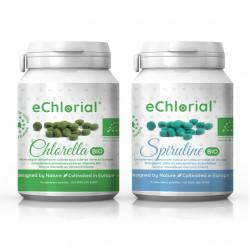
Discovery Duo ! (2x100g) Chlorella + Spirulina
